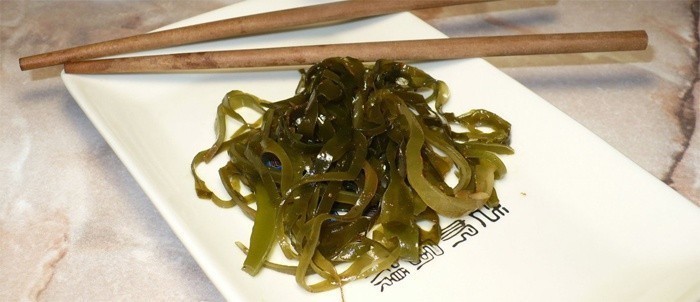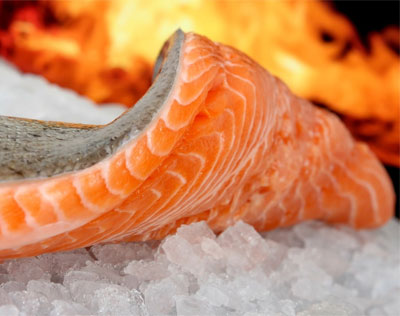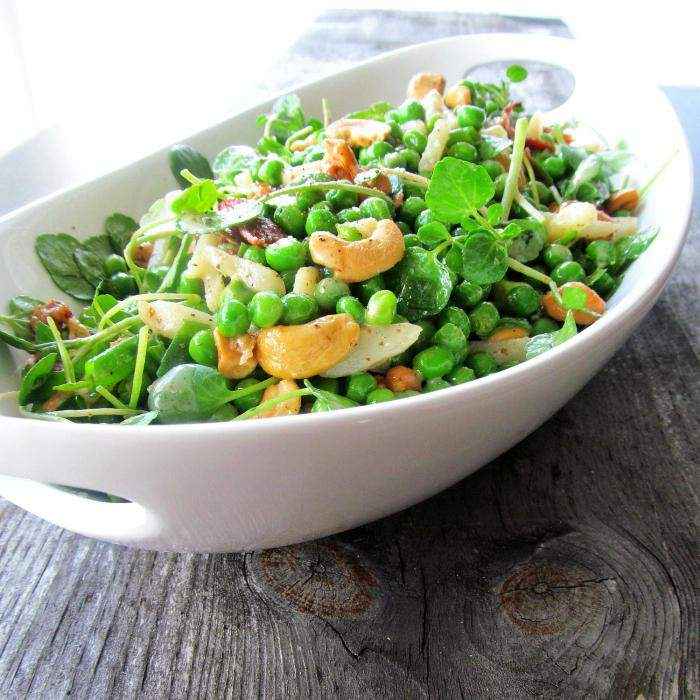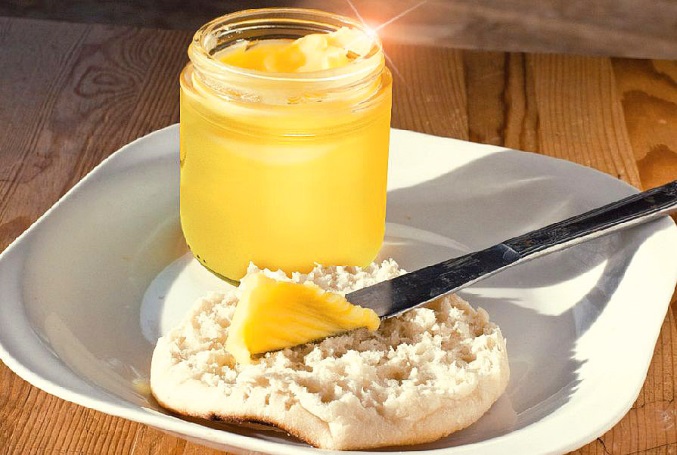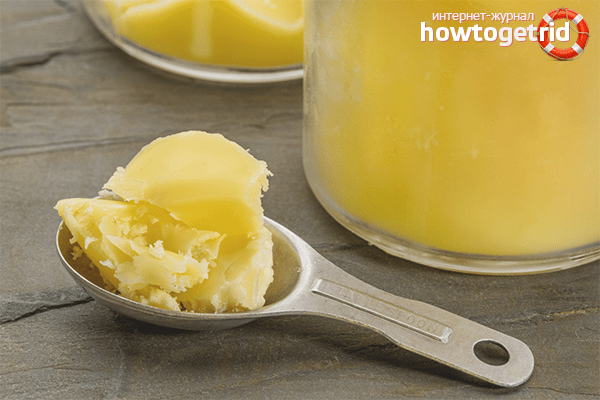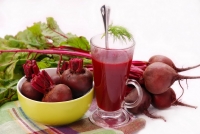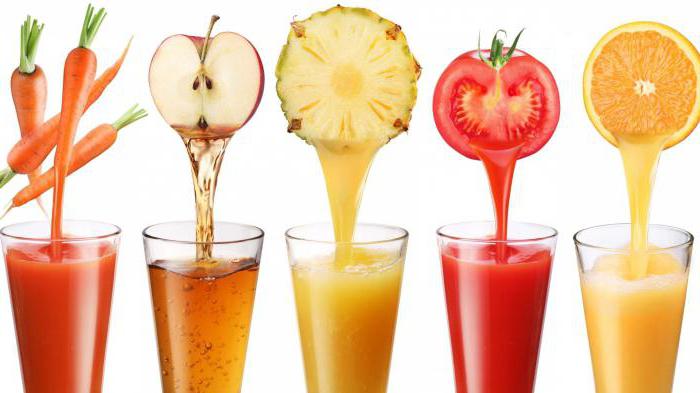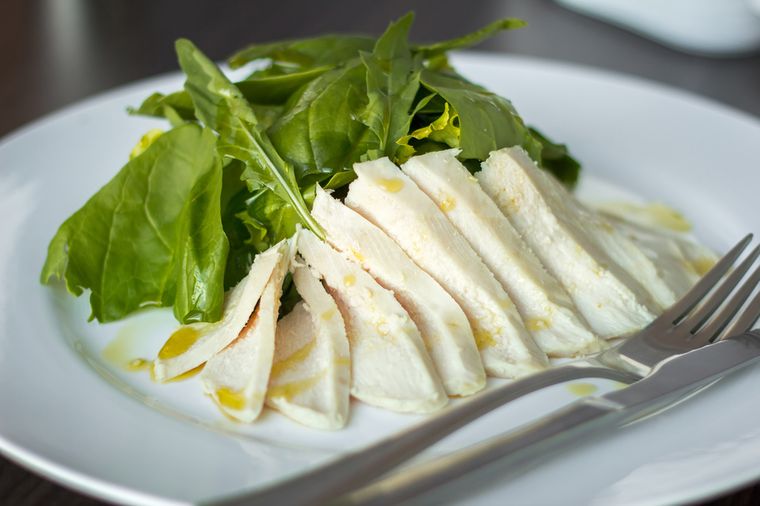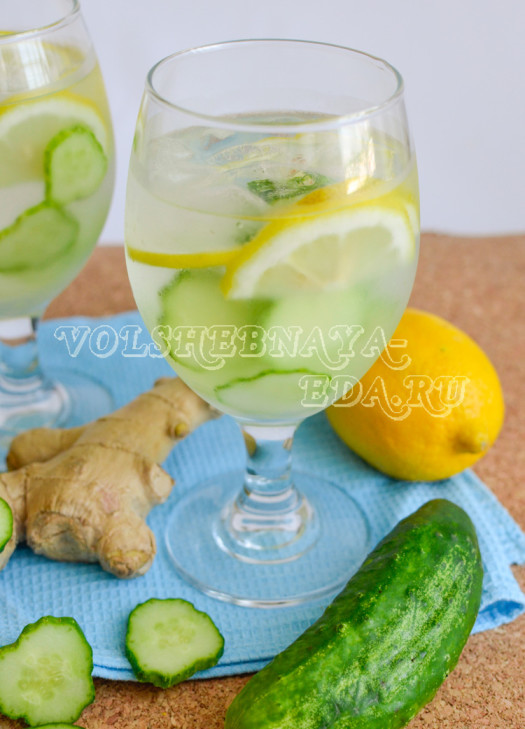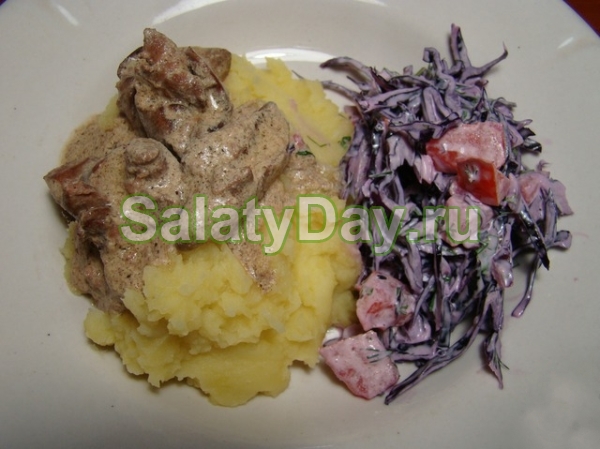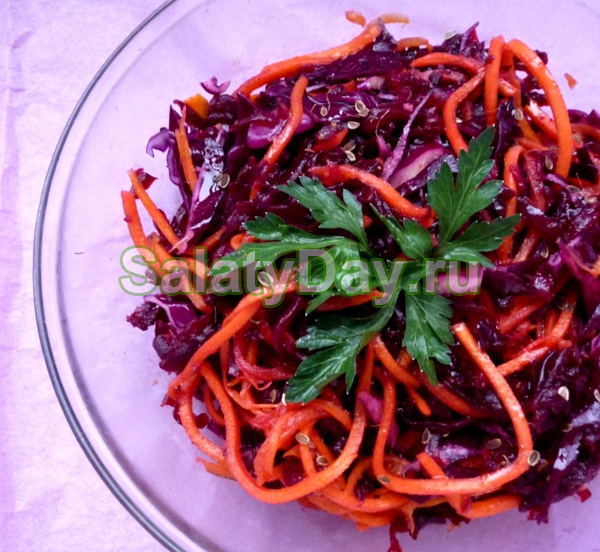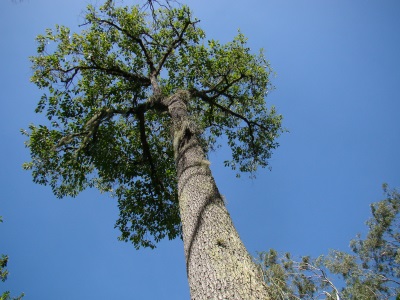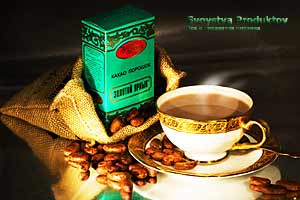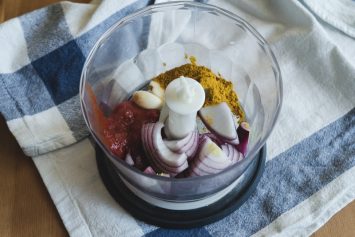Melted butter. Ghee ghee
"Liquid Sun" is called ghee in India, in the homeland of Ayurveda. For centuries, this product has been used not only in cooking, but also in folk healing. The benefits of ghee are really great, but only if the product is properly cooked.
What is ghee
Ghee is obtained by special processing of butter. The bottom line is to expel all water, protein and lactose from a natural cow product. The result is a highly concentrated animal fat, free from harmful impurities.
You can cook ghee in industrial and home conditions. Moreover, the methods of processing ordinary butter are significantly different. If the industrial method involves the use of a centrifuge, then the housewives, for obvious reasons, use the method of heating the initial product in a water bath.
At the same time, a characteristic foam forms on the surface of the melted oil coma, which must be removed. It contains curled protein. As for the excess water, they simply evaporate when heated.
In order to bring the cleansing process to the ideal, some housewives additionally filter ghee through a gauze filter or a simple sieve so that not a drop of foam gets into the finished product. The result is a clear, transparent, gold-colored oil that really resembles molten gold.
Useful qualities of ghee
Almost one hundred percent fat content in finished ghee indicates its high nutritional value. It is important that treatment by heating at home allows you to maintain the optimal amount of vitamin D, A and E. Moreover, by removing water and protein, the amount of these essential vitamins for beauty and health is increased.
The main culinary meaning of obtaining a melted cream product is to increase its shelf life. In hot climates this is absolutely necessary. Ordinary butter at room temperature will deteriorate within a few days. Ghee will retain its nutritional and taste properties for at least a year. Experienced housewives say that a properly prepared product can stand for five or ten years without rancid.
The benefits of ghee are special knowledge, which is mainly associated with Ayurvedic knowledge. However, even without it, you can understand that the product is useful due to the concentration of vitamins and high energy value. And Russian folk healers also knew about the benefits of ghee. Using it, our ancestors prevented rickets, osteoporosis, decreased vision, metabolic disturbances.
In this case, the dangers of ghee, prepared without technological disruption, are spoken of in rare cases. They are mainly associated with food abuse.
Healing properties of ghee
If highly concentrated cow oil is prepared correctly, then it can be used not only for food but also for medicinal purposes. In traditional medicine, the product is used as a safe medicine that can help against certain diseases. It is used both externally and internally.
Externally melted oil is used both for massage and for rubbing certain parts of the body. According to Ayurvedic knowledge, the product contains concentrated warming life-giving energy of the sun. It is used like this:
With frequent headaches, you need to rub a small amount of the product, literally half a teaspoon, into the temporal region, calves of the legs, shoulders and palms. It would be good for women to lubricate the area of \u200b\u200bthe appendages;
If joints often hurt, back pain is tormenting, then oil will warm the body and soothe. Rub a small amount of oil in those places that bother the most;
At the first sign of a cold, rub your feet and hands with oil and go to bed.
People with reduced immunity can use ghee to increase the energy of the body, strengthen the immune forces, fight depression and bad mood. The effectiveness of the procedure increases if you do it regularly before bedtime.
Inside the product is used if you need to improve health:
Improve digestion;
Simulate the production of enzymes;
Normalize metabolic processes;
Debug bowel movements;
Get rid of physical weakness, weakness;
Boost immunity.
Inside, the oil is taken in a small amount - not more than one teaspoon - after eating. Ayurveda teaches that if a person has a disrupted digestive system, then the development of numerous serious diseases is only a matter of time. Reception of melted butter quickly, safely and effectively solves this problem by gently restoring the digestive tract.
But in order to strengthen the immune system, oil should be eaten on an empty stomach, mixed with honey, fruits, nuts or oriental spices (saffron, cardamom, fennel, cinnamon). Spice on a teaspoon of the product you need literally a pinch. To enhance the benefits of such an immunostimulating agent, it can be combined with fresh dairy products, for example, natural yogurt. The first results will be visible literally in 3-4 days.
Harmful ghee
Despite the undoubted benefits and nutritional value of clarified ghee, we must not forget about its potential harm. We are talking about pure fat, which can disrupt the gastrointestinal tract, instead of curing it.
In addition, fatty ghee is harmful to the pancreas and dangerous to the liver. If a person suffers from diseases of these organs, he needs to refuse treatment with oil or use it for food purposes. We must not forget about cholesterol, which is in the product. Abuse of it is a direct path to the development of atherosclerosis and metabolic diseases.
Ghee is very high in calories. Therefore, those who want to lose weight or suffer from obesity should not use the product. Anyone else can use frying oil. It does not burn, does not bitter and has a wonderful taste.
How to cook ghee
Cooking ghee at home is easy. However, the spread, that is, a product with herbal supplements, is not suitable for these purposes. It is necessary to heat the butter containing at least 82.5% milk fat.
How to do it:
1. cut the existing oil into pieces;
2. put in a pan and put on a small fire;
3. Once the oil has melted, the fire must be reduced to a minimum. The pan cannot be covered with a lid, otherwise the water will not evaporate. Oil must languish, boiling is unacceptable. At first, the color of the melted oil will be dark, but it itself is cloudy. This is normal;
4. When a lush foam cap forms on the surface of the oil, do not rush to remove it. The foam should settle a little by itself, otherwise you will remove it and throw away too much fine oil with it;
5. after the foam has settled, it must be removed with a slotted spoon;
6. the oil should be swept further, at the rate of languishing per kilogram of the original product. In the process of languishing, do not stir the oil with a spoon;
7. If foam appears during this time, it must be removed.
When the oil becomes transparent golden and acquires an amazing nutty flavor, it is ready. You can strain the product, then pour into glass jars. Store ghee in a plastic bowl is not recommended.
Ghee was widely used in ancient India. The sages claimed that such a simple product is able to rid the human body of many ailments. Ghee is achieved by heating the composition and removing excess water, lactose and protein from it. The composition is used for the prevention of various diseases. The product is also applied to damaged areas of the body.
What is ghee
- The product is obtained through prolonged heat treatment. As a result, high concentration animal fat is obtained from butter. As a result, there are no harmful impurities in the melted product.
- Ghee is usually extracted in two classic ways. In the first case, the product is processed on an industrial scale using a centrifuge. The second option is significantly different.
- The product is installed in a steam bath and heated until excess moisture evaporates from the composition, excess enzymes come out. In the second case, a foam forms, which must be disposed of, and it contains protein.
- Moisture disappears through heating and further evaporation. It is easy to bring the mixture to a perfect consistency. For this, the housewives resort to using a small sieve or a gauze filter. The composition is filtered in a separate container.
- In the process of filtering the product, an ideally pure mass of saturated yellow is obtained. In ancient India, the sages called the composition liquid sun or molten gold. In this form, the product can be stored for a long time.
Features of ghee
- Ghee contains the highest percentage of fat, so the product carries high nutritional value. Heat treatment of the composition at home allows you to save the necessary vitamins in ghee (E, A, D).
- After evaporation of the liquid and removal of the protein, the concentration of trace elements increases significantly. Enzymes help maintain human health and beauty. Basically, butter is processed into a ghee for longer shelf life and usefulness.
- If you live in a hot climate, such conditions adversely affect the products. Classic butter is not suitable after several days of storage at room temperature. A melted composition under the same conditions can be held for about 1 year or more.
- The benefits of ghee have become known thanks to Indian teachings. Also, you do not need to be an expert to evaluate the fully rich vitamin composition of the product. The composition contains a concentration of vital trace elements and high energy value.
- In ancient times, ghee did not pass Russia by. Experienced elders knew about the healing qualities of the product. Our ancestors actively struggled with osteoporosis, rickety, poor eyesight and problems of the gastrointestinal tract with ghee.

- If you follow a number of rules for the processing of butter into a melted composition, it can be used not only for food purposes, but also in the fight against many ailments. It is known that ghee is widely used in folk medicine.
- The product is loved for its effectiveness and safety for the body. Ghee, if properly processed, cannot actually harm a person. The composition is widely used for indoor and outdoor use.
- Often oil is applied as a massage tool or to grind various parts of the body. If you rely on the ancient beliefs of the people of India, the composition has the life-giving energy of the sun, which is able to warm and heal a certain ailment.
- Ghee is effective for frequent migraines and headaches. It is enough to take 10 gr. product and begin to slowly rub the composition into the temples, shoulders, hands and calves. Girls are advised to grind the area of \u200b\u200bthe appendages.
- If you suffer from frequent joint pain or discomfort in the lumbar region, ghee in the form of grinding will relieve inflammation and soothe the nerve endings. Rub with a small amount of the composition of the place that is most discomforting.
- Ghee is especially effective during colds. If you have the first symptoms of an ailment, it is strongly recommended to rub the composition on the palms and feet. After the manipulation, go to bed.
- Ghee is effective for raising the immune system and overall body tone. After taking the product inside, you will soon feel better. The composition is effective against depression and malaise.
- Eat small amounts of ghee before you go to bed. Thus, you normalize the activity of the digestive organs, the production of enzymes and metabolic processes. Immunity will increase, weakness will disappear.
- Also, the product can be eaten at 15 g. after eating. Such manipulations are carried out to relieve ailments of the digestive system. Soon all diseases will disappear. Ghee in the shortest possible time gently restores the digestive tract.
- If the emphasis is only on raising the immune system, then the product should be consumed on an empty stomach. It is advisable to combine the oil with fruits, honey, nuts or spicy spices. Effective composition in combination with natural yogurt. The result occurs in the first few days.
Harm to the body of ghee
- Despite all the benefits of ghee and nutritional value, the product can harm the body. This is almost pure fat, so if you do not observe the daily rate of the product, you can damage the gastrointestinal tract.
- Ghee also significantly harm the liver and pancreas. If you have found pathologies associated with these organs, it is strongly recommended that you refuse to use an animal product.
- The ghee product has a high cholesterol content, so oil abuse will lead to the development of metabolic diseases and the occurrence of atherosclerosis.
- It is forbidden to eat the product to people who are obese. The composition is considered to be very high in calories, so the use of ghee can aggravate the situation and provoke an even greater set of adipose tissue.
- The product is great for frying and has a unique taste. Individuals who do not experience such problems will like dishes that are cooked in ghee. The product is not bitter or burning.

- To make ghee at home, you do not need to have special knowledge and skills. The only condition is that only a natural composition without additives is suitable for a quality product.
- For such purposes, it is necessary to melt the butter with a fat content of at least 82%. Chop the composition into pieces, send to the pan of the appropriate volume. Turn the stove on medium power, wait for the thawing of the oil.
- Reduce the power of the burner to a minimum; do not cover the pan with a lid. Otherwise, moisture will have nowhere to go, it will remain in the composition. Carefully monitor the process, it is forbidden to allow the oil to boil.
- Do not be alarmed if, at the beginning of the manipulation, the composition is dark in color with a muddy base. Such a process is quite normal. Do not rush to get rid of lush foam in the process of languishing the product. The hat should settle a little.
- To remove the foam, resort to a classic slotted spoon. After this, the oil should be languished at the rate of 1 hour per 1 kg. product. It is strictly forbidden to stir the composition with any devices.
- The readiness of ghee can be determined by the pleasant nutty aroma and transparency of the mixture. For a cleaner composition, pour the mass into glass jars through a gauze or cloth filter. Do not store oil in plastic.
Ghee is of great benefit to the human body. If you have no contraindications to the use of the product, the composition will help you improve overall health, and suppress the presence of possible ailments. The main condition remains that the product must not be abused, otherwise you can aggravate the course of diseases and provoke obesity.
Video: treatment of bronchitis and cough with propolis in ghee
Ghee is a mixed product. On the one hand, it is difficult to overestimate its excellent taste, its benefits for health promotion and the possibility of widespread use in cosmetology. On the other hand, oil is primarily fat, and fats, due to the craze for a healthy lifestyle, are practically anathema. Therefore, we will consider the benefits and harms of using ghee, find out that “scary” cholesterol is actually not so scary, and we’ll learn some new beauty recipes.
Ghee: “good” or “bad” fat?
In simple terms, ghee is butter from which milk proteins, water and lactose have been removed. As a result, high-calorie cream becomes even more high-calorie product, because according to GOST 100 grams of ghee must have at least 99 grams of milk fat, which, in turn, consists of at least 35% unsaturated fatty acids. What does this mean?
According to a common misconception, the best “fuel” for the human brain is carbohydrates. However, it is worth remembering that more than two-thirds of the brain consists of fats, most of which are unsaturated fatty acids and omega-3 fatty acids. Therefore, for the full and productive work of the brain, fats are simply necessary. Unfortunately, supporters of various “fat-free” diets often forget about this.
This, of course, does not mean that you need to thoughtlessly absorb oil, lard and other high-calorie "bombs", because fats are different for fats. Without going into details, the composition of fats is divided into two large groups - consisting of saturated (conditionally "bad") and unsaturated ("good") fatty acids. As you might guess, it is the unsaturated fatty acids that benefit. By the way, these include omega-3 and omega-6 fatty acids, which everyone who has heard a little interested in healthy nutrition has heard about.
It is the higher content of unsaturated fatty acids that makes ghee different from other fats of animal origin. Linoleic acid (omega-6) in its composition provides the growth and development of cells and tissues of the human body and is involved in the synthesis of sex hormones. In addition, ghee is rich in various trace elements - in particular, calcium, iron, magnesium, phosphorus, potassium, and vitamins A, D, PP, E.
Linoleic acid, like other polyunsaturated (irreplaceable) fatty acids, is not able to be synthesized during metabolism and must be ingested with food. Thanks to it, fat metabolism is normalized, dry skin is reduced, and cell membranes are maintained in a normal state. A lack of linoleic acid in the body leads to eczema and hair loss.
However, in addition to useful vitamins and minerals, ghee includes trans fats and cholesterol, and the energy value is at least 890 kcal per 100 grams of product. Moreover, the cholesterol in this product is 25% more than in cream. In addition, there are almost two times more “bad” saturated fatty acids in it than “good” unsaturated ones. Saturated fatty acids lower the body's sensitivity to cholesterol, as a result of which it is retained in the bloodstream, therefore, the risk of deposition of cholesterol on the walls of blood vessels increases. But saturated fatty acids also have a positive quality: they give our body energy.
Useful properties of ghee
The benefits of consuming the product are beyond doubt, because, as mentioned above, it contains the unsaturated fatty acids our body needs.
Table: ghee chemical composition
The aforementioned product, unlike its "brother", is more convenient in everyday life, especially in frying foods. Firstly, it does not burn, while anyone can burn, contributing to the release of free radicals. When frying, it does not foam, does not form carcinogens and, therefore, does not adversely affect the liver. Moreover, the product is a source of antioxidants, which, on the contrary, neutralize free radicals that somehow get into our body. Secondly, melon has a much longer shelf life compared to cream: it is safely stored for a year at room temperature, does not oxidize and does not rancid, so it can be taken on trips and trips.
According to the traditional system of Indian medicine, Ayurveda, ghee is a miracle cure that heals and rejuvenates the human body. It is called Ghee. The cooking technology is slightly different from what we know, and the result is a caramelized product with a light nutty flavor and aroma. From time immemorial, ghee in India was considered a sign of prosperity and was called "liquid gold." Ayurveda says that the medical benefits of ghee are greater, the longer it "ripens", and a century-old ghee is considered an elixir of immortality.
However, much more often the product is used for medical and cosmetic purposes. One of its properties is the improvement of complexion and general condition of the skin. And this applies to both eating and making masks and compresses based on it.
Eating food regulates the metabolism and improves digestion, favorably affecting the functioning of the gastrointestinal tract. It also helps maintain the elasticity of blood vessels, preventing the occurrence of varicose veins, increases immunity. In addition, the use of ghee has a positive effect on intelligence: memory improves, cognitive abilities increase, the central nervous system is maintained in good shape.
Benefits for the female body
The use of ghee has a beneficial effect on the female body. This does not mean that it is contraindicated for men, it’s just more beneficial for women, and this is due to some physiological characteristics, because fatty acids are especially needed for those who have experienced problems of anemia and anemia, and these problems are considered to be genuinely “feminine”.
It is imperative to include ghee in your diet during pregnancy, especially in the first and second trimesters, when the future baby is actively developing and internal organs are formed, because the fetus receives all the necessary nutrients for normal formation and development exclusively from the mother. Since ghee is rich in calcium, its use helps the formation of a healthy skeletal system of the child. However, do not forget that this is a very high-calorie product, and you can not abuse it, this is fraught with weight gain.
Is it possible for children: “for” and “against”
Pediatricians are unanimous on the issue of using ghee (and butter) in children’s diets: the product should be, because the substances contained in it are easily broken down and absorbed by the body by 98%. Moreover, children need to eat it more than adults. The milk fats and vitamins that make up ghee are necessary for the child to grow and develop normally and fully: Vitamin A is responsible for color perception, B2 for hair growth, and it also ensures healthy skin and nails. In the winter season, there is an acute problem of a lack of vitamin D, which is mainly synthesized by the skin under the influence of ultraviolet rays and to a much lesser extent enters the body with food - including that found in oil. Adequate intake of vitamin D in the body avoids rickets and forms a healthy, strong skeleton. And, since the dish does not contain aggressive proteins of cow's milk and milk sugar, this product is recommended for children with lactose intolerance.
Fat is an integral part of a children's diet. It is fats that provide children with the calories that they need as a source of energy for growth and active life, so the amount of different fats in the children's menu does not need to be so strictly limited as in the diet of adults. Fats should be less than 30% of the calories in your child’s diet, and no more than one third of them should be saturated fats.
Komarovsky E.O.
http://www.komarovskiy.net
At the same time, the presence of cholesterol in ghee and its increased calorie content with excessive enthusiasm for this product are fraught with impaired fat metabolism.
Another question is at what age to give it to children. The timing of the introduction of creamy and ghee is individual and depends on the state of health and physical development of the child. Here the opinions of pediatricians differ: Dr. Komarovsky recommends introducing it into the child’s diet starting from one year, in other sources there is an opinion that children can be given the product with the beginning of cereal feeding - that is, from 5-6 months, but in microscopic doses, at the tip of the tea spoons. Children with low body weight are recommended earlier dates for the introduction of complementary foods, therefore porridge and oil are introduced into the diet from 4-5 months, and for overweight babies, on the contrary, later.
When ghee is harmful
Fats of animal origin are contraindicated in those who suffer from diseases of the gastrointestinal tract. Of course, the use is useful for the mucous membrane, but not when the stomach and intestines can not work in normal mode. Overuse of the product can cause exacerbation of diseases of the liver and gall bladder, pancreas. It is necessary to strictly limit its use by people with various metabolic disorders (gout, diabetes), diseases of the cardiovascular system.
Contraindications: pancreatitis
As you know, with pancreatitis, the consumption of dairy products with high fat content is sharply limited, because enzymes produced by the pancreas are necessarily involved in the breakdown of fats. However, it is not necessary to completely exclude oil from the diet, especially during remission, it is enough to strictly limit its amount.
Great and terrible cholesterol
In 2005, the World Health Organization recommended reducing the consumption of dairy products with high fat content, which include ghee. This is due to the fact that with excessive consumption of milk fat, of which the dish consists of 99%, cholesterol levels increase and, accordingly, the risk of diseases of the cardiovascular system increases.
Cholesterol is a fat-like substance that performs a number of important functions in our body: it is a building material for all cells of the body, it ensures the stability of cell membranes and is a raw material for the synthesis of hormones and vitamin D. Cholesterol is also involved in the process of building bile, which means necessary for the digestion and elimination of toxins from the body. Moreover, about 80% of cholesterol is produced by the body itself. However, an excess of cholesterol in the body is very dangerous and leads to blockage of blood vessels, thereby disrupting the delivery of oxygen and nutrients to the cells, which threatens the death of tissues. If this happens in the brain, a stroke develops, in the heart - a heart attack.
The daily intake rate set by the World Health Organization is 10 grams for a healthy adult.
Excess weight
The cornerstone of weight management is energy balance. Weight gain and weight loss depend on the difference between calories consumed and spent. A person can lose weight by eating cakes and cakes only if they do not exceed his total daily calorie intake. Just as you can get better, eating only chicken breast and buckwheat.
The same statement is true for ghee: if its calorie content “fits” with the total calorie content of your diet, then eat it for health! Another thing is that you need to know the measure in everything, so it is better to strictly limit the use of high-calorie foods to people who are trying to reduce their weight, because it is so easy to "go over" your norm and not notice.
To whom and how much is needed for good
As stated above, for adults, WHO has limited food intake to ten grams per day. Believe me, this is not so small, especially if you do not have it as an independent food product, but add it to various dishes to improve their taste - for example, in cereals and sauces.
The rate of consumption of fats, including animal origin, for children is strikingly different from the "adult" norm, because a growing body needs more nutrients. To begin with (from 6 months), a child needs only 2–4 g per day, by the year the norm can be raised to 6 g. By three years, the child can be given 10 g of ghee per day, and from four the norm can be raised to 20 g. Volume is better distribute for several meals. And we should not forget that, although the product is a valuable source of vitamins and minerals, its excess can adversely affect the children's body, affect the work of the liver and pancreas.
Health Recipes
Regarding the use of ghee in food for medicinal purposes, there are a number of nuances. It's no secret that in our food culture traditionally there are many fats of animal origin: they are found in fish, eggs, meat. Therefore, the use of ghee in food for medicinal purposes, unlike the people of India, where ghee treats literally everything with oil, has never been especially common, and, in some way, does not even make sense. Another thing, if you are a vegetarian or stick to a "low-fat" diet - then the following recipes are perfect for you.
With weakened immunity, it is recommended to use oil in the morning, but not by itself, but with spices, nuts, dried fruits. From spices suitable cardamom, saffron and fennel. You can also add honey. Moreover, breakfast should consist exclusively of butter with additives.
Digestive disorders, metabolic disorders and inflammatory processes are treated with ghee mixed with medicinal herbs. Proportions - two thirds of the oil and one third of the herbs (sage, wormwood, chamomile, St. John's wort, flowers and leaves of honeysuckle).
Ghee is an excellent base for ointments. For example, mixed with streptocide, suitable for the treatment of wounds. Ghee, mixed with calendula, chamomile, yarrow and acacia flowers, is also great for healing and relieving inflammation.
And of course, it is best to use ghee made by yourself.
Video: how to cook the product
In the process of cooking, it is better to melt the oil in a water bath, and not on an open fire, because if the oil burns, it will darken and begin to emit a pungent odor. In this case, eating it will not be useful and unpleasant.
Beauty recipes
Ghee has miraculous power when used for cosmetic purposes. It quickly penetrates the pores and is well absorbed into the skin, where it actively dissolves and removes accumulated toxins and toxins. Therefore, through the use of ghee, the skin becomes soft and soft.
Face masks
For dry skin
Such a mask is suitable for you:
- mashed potatoes
- turmeric
- melted butter
Mix the ingredients, apply on face for 15 minutes, rinse.
Result: The skin is softer and more hydrated.
Wrinkle age mask
- castor oil (1 tsp)
- ghee (1 tsp)
- iodine (1-2 drops)
- honey (1 tbsp. l.)
Mix all components, apply on face skin for 2 hours. The mixture must be stored in the refrigerator and used no more than 2-3 times a week.
Result: The skin is more toned and supple, age spots and wrinkles are less noticeable.
From swelling of the eyelids
- 1 chicken egg
- ghee (1 tsp)
Separate the yolk from the protein and combine with softened butter, mix thoroughly. Using cotton pads, apply a thick layer on the skin around the eyes.
Result: Puffiness of the eyelids decreases, “facial” wrinkles are less noticeable.
Hair care
Mask for dry hair. Mix a teaspoon of warm milk, olive and ghee. Rub the resulting mixture into the scalp and slowly comb the hair, distributing the mask along their entire length. Then wrap your head in a warm towel. Wash off after 15–20 minutes.
Against hair loss. Take 30 grams of calamus root and licorice per liter of water, prepare a decoction. Then, mixing it in equal proportions with ghee, evaporate the excess liquid over low heat. Rub the mixture into the hair roots, leave for 15-20 minutes, then rinse.
To strengthen thin hair the best mask is a mixture of ghee and any vegetable oil, and lemon juice in free proportions. Apply the mask to the scalp and distribute along the entire length of the hair, rinse off after half an hour.
There is no doubt that the key ingredient in the recipes of every housewife is butter, especially if you like to bake cakes, pastries, puff pastry. For this reason, we can say that it is an indispensable product in our kitchen. Butter is a food product containing lactose and obtained by processing cow's (or other types of cattle) milk.
Compared with other types of dairy products, butter contains on average more calories, about 750 per 100 grams, than, for example, milk, which contains 40-65 calories, depending on the type, and non-fat about 30 calories.
Types of butter can be classified according to several factors: the origin of milk (from a cow, sheep, goat, etc.); salt content; fat content (for example, there is a softer one, which is easier to apply on bakery products or stiffer, which is ideal for baking).
But basically three types are known:
- Sour. It turns out in the process of whipping cream.
- Sweet. In the process of special processing.
- Clarified or melted, obtained from melted butter. (We have known it since the days of ancient India, where ghee was called).
Is ghee useful? In the cuisines of many countries of the world, it is considered the recognized king among oils and fat-containing products, amber-colored oil, valuable for gastronomy.
It is called differently: peeled, dehydrated, ghee, or ghee.
Cooking Ghee Ghee


Ghee is obtained as a result of clarification of ordinary butter (many advise using it with higher fat content) obtained from cow's milk by separating fats and proteins from water.
Ghee or ghee (this name comes from the Ayurvedic tradition), is a food that our ancestors ate many years ago and which has wonderful properties, both tasteful and medicinal. In traditional medicine, it is still used.
Ghee is used in your diet even by vegans, who eat only live foods, as it brings beneficial substances to their diet. For example, vitamins D, K2, and some others are almost impossible to obtain from plant sources.
Doctors of Ayurvedic medicine talk a lot about the benefits of ghee and recommend its use, since this natural product has the ability to balance 3 doshas - the fundamental vitality - vata, pitta and kapha.
Ghee is cooked by melting unsalted butter at low temperatures until all the solid particles of milk are separated from the fat. The result is a stable product that is ideal for cooking or frying and, of course, does not contain trans fats. It does not require cooling, and, in accordance with the ancient Ayurvedic tradition, has many useful and healing properties.
Trans fats are found in all foods if they have been processed with chemicals, such as refined oils and margarine. When these substances enter the body, they linger in it for years, so when frying it is better to use not vegetable oil, but ghee.
Homemade ghee cooking
Ghee is easy to make at home, as it is made from regular butter. Depending on your taste and financial circumstances, it is better to buy good quality and unsalted butter.

- It is necessary to melt the product in a bowl, preferably with a thick bottom, to prevent burning. Fire should not be too strong for the same reason.
- When the oil begins to boil, foam will form on the surface. Reduce the fire to a minimum and do not cover the bowl with a lid.
- Hard lumps will appear on the surface, which must be removed.
- Make sure that the liquid is light and transparent, because if it is dark and has a strong smell, it means that the oil is burnt.
- The process of preparing a kilogram of the starting product will take about half an hour.
- The weight of the finished ghee will be reduced by 20%, and the result will be an amber-colored liquid that is transparent enough so that you can see the bottom of the container. In India, it is called "liquid gold."
- After this, pour the finished product into the pan and let cool (without lid).
- Finally, after cooling, you can cover the pan with a lid and put it in storage.
- After we removed the substances that give bitterness to the oil, you can store it both in the refrigerator and outside it, at room temperature, this does not affect the properties of the product.
What is useful ghee

- Ghee is a very nutritious food because it contains a lot of fat-soluble vitamins and at the same time helps the absorption of other nutrients when eating. Many sites write that with a healthy diet, it is recommended to consume vegetables with some type of fat that contain fat-soluble vitamins A, D, E and K.
- Ghee also contains butyric acid, which has antiviral and anti-cancer properties.
- Ghee at home can be used in the preparation of dishes that are ideal for those who suffer from allergic reactions or are sensitive to cow's milk, since all milk residues are practically eliminated during its production.
- There is information that most people with milk allergies can tolerate the addition of ghee to food (but remember that we are all unique, so it’s best to do an individual tolerance test in advance).
Ghee, its benefits and some wonderful properties
- The ability to heal the skin. For example, with burns that you may get during cooking. Just apply the ghee to the place of the burn or wound and in a few minutes the pain will pass, but the scar will not remain! Imagine that the properties of ghee and on the internal organs will be the same healing.
- Adding to cosmetic products helps moisturize, acquire smoothness and tenderness of the skin, removes harmful chemicals and impurities from the body.
- It is very useful for treating cracks on dry lips, they can process the nasal mucous membranes, protecting them from drying out and getting various infections.
- It helps digestion and assimilation of food, has a general tonic effect on the body, increases mental performance, has a positive effect on the nervous system and does not increase cholesterol.
- It is a good source of vitamins.
The harm from the use of ghee can only be associated with its fat content, so it is better to observe the measure when it is used by people who are overweight, digestive problems, as well as diseases of the liver and pancreas.
Conclusion

Summing up, we can say that ghee is an excellent product and its benefits are undeniable. It is an excellent ally in culinary affairs, giving taste, aroma and brilliance to the finished dishes. It can also be recommended because it has been widely used since ancient times and has proven its worth. Ghee is a favorite fat-containing product that is used by French and Indian chefs, and indeed the whole world. If you get ghee at home, you must take care of the quality of the starting product and choose the most suitable for you in terms of taste and salt content. Obviously, however, it is necessary to control oil intake and maintain a balance of good and bad fats.
Ghee recipes are found in any kitchen in the world. For example, if you cannot refuse fried meat, then it is better to cook it for ghee and eat with vegetables, and season salad with high-quality olive extra virgin.
The benefits of ghee have been known to people for thousands of years.
The first documented evidence of the use of this product is dated 2000 BC.
Mankind has used and uses ghee not only as a food product, but also for ritual practices, as well as in Ayurvedic medicine, whose experts believe that this product cleanses both mentally and physically.
What is ghee butter?
Ghee is called creamy, which was cleaned of impurities, excess water, sugars and protein by slow boiling. The elimination of impurities makes the product more resistant to subsequent exposure to high temperatures, without depriving it of any useful properties.
Which oil is more useful: butter or ghee?
Ghee.
And that's why.
- There are no dairy components. Some people suffer such that they cannot eat even butter. Ghee is completely devoid of both lactose and casein. Therefore, it is allowed to all.
- A lot of short fatty acids. Ghee is much more than butter, short-chain fatty acids, especially. This compound has anti-inflammatory activity and helps prevent cancer, normalizes digestion and maintains the correct level of sugar in the blood, promotes weight loss and improves the cardiovascular system.
- Higher smoke point. For butter, this figure is approximately 176 degrees Celsius, for ghee - 232. Why is it so important? Because the higher the smoke point of oil, the more it is suitable for cooking, since it does not oxidize for a long time when heated. Namely, oxidized fats have the most powerful negative effect on the body.
- A lot of fat soluble vitamins. There is much more vitamins in ghee than in butter, such as A, D, E. Vitamin A absorption is often impaired in people, irritable bowel syndrome, Crohn's disease, and many pancreatic pathologies. Vitamin D is formed in the sunlight. But this light is rare in our country. And even in the summer it is not accessible to everyone, since it is quite difficult to sunbathe in a metropolis. Vitamin E is a powerful antioxidant, a lot of which virtually no one has. In addition, this compound is necessary to maintain the correct hormonal levels and reduce "bad" cholesterol.
- Pronounced taste. The aroma and taste of ghee is stronger than that of butter. And therefore, much less is required for cooking this product.
Does ghee oil help you lose weight?
Yes. And in several ways at once.
- Medium and short chain fatty acids, which are very numerous in this product,. And at the same time, they prevent the formation of new body fat.
- In Ayurvedic practice, ghee is one of the central elements of a general healing and weight normalization diet. It is believed that it improves the functioning of the gallbladder, which immediately positively affects the entire digestive system. And the proper functioning of the gastrointestinal tract is one of the necessary conditions for sustainable weight loss.
- The anti-inflammatory activity of short fatty acids helps them eliminate chronic sluggish inflammation in the body, which is the trigger for a large number of diseases, including for gaining excess weight.
- Butyric acid and other short chain fatty acids maintain proper blood sugar levels. This is important not only for patients with type 2 diabetes, but also for people who are overweight. Since it is usually formed on the background of insulin resistance, it is impossible to get rid of it without lowering blood glucose levels.
Ghee and linoleic acid
Another positive property of ghee is the theoretical presence in it, which helps to lose weight, reduces inflammation, normalizes blood pressure and has other useful properties.
Why is the presence of this compound in ghee called “theoretical”? Yes, because linoleic acid is available only in that oil, which is obtained from the milk of cows grown on free pasture on the grass, and not fed with soy and fish flour.
Which ghee to use: purchased or home-made?
Only made by yourself at home. On the shelves of stores under the guise of a melted pastel very often lie trans fats.
Is there any harm?
No. If you use the product in reasonable quantities.
The negative effect of ghee, which he has been credited with for many years - an increase in cholesterol, is not confirmed by any modern studies.
Moreover, according to fresh scientific data, against the background of a regular likening of ghee oil, the level of low density lipoproteins (“bad” cholesterol) and triglycerides decreases. Moreover, positive results are noticeable, both in blood serum and in the liver.

